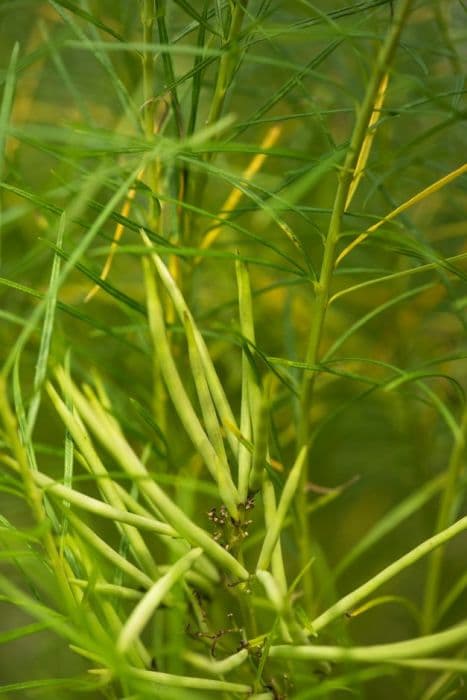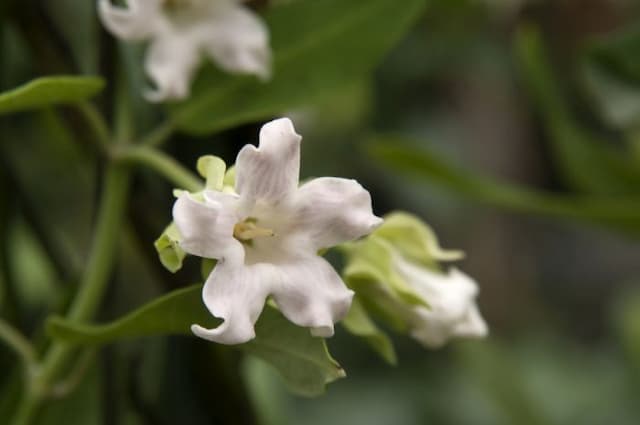Frangipani Plumeria rubra

ABOUT
Plumeria rubra, commonly known as Frangipani, is a striking plant renowned for its vibrant and fragrant flowers. The flowers of the Frangipani are its most distinguishing feature; they are typically about two to four inches in diameter. They exhibit a delightful palette often comprising of shades like white, pink, red, and yellow, frequently blending these colors within a single blossom. Each flower is formed by five broad, waxy petals that emerge from the center in a spiral, creating a propeller-like shape. At the center of the flowers, there is a small contrasting area, which is often another shade, giving Frangipani blossoms a dramatic, exotic appearance. The color intensity of the petals may vary, intensifying towards the center, and can offer a gradient effect that is quite visually striking. The plant's branches are thick and sturdy, radiating out from the main trunk and providing a robust framework for the foliage and flowers. The leaves are large, glossy, and have a leathery texture with a rich green hue, presenting an elliptical shape with pointed ends. They can grow quite long, and they are arranged in a spiral pattern along the branches, giving the plant a lush, tropical look. Frangipani's overall structure allows it to showcase its flowers prominently, as they cluster at the ends of the branches, providing a canopy-like effect that is not only attractive but also makes the flowers easily accessible for people to admire or for pollinators such as moths. In essence, the Frangipani is a masterpiece of nature that embodies the tropical essence through its flamboyant flowers, aromatic presence, and glossy green leaves. Its look is evocative of warm climates and is often associated with relaxation and paradisiacal imagery.
About this plant
 Names
NamesSynonyms
Frangipani, Red Frangipani, Common Frangipani, Temple Tree, West Indian Jasmine.
Common names
Plumeria acuminata, Plumeria acutifolia, Plumeria angustifolia, Plumeria aurantia, Plumeria bicolor, Plumeria caracasana, Plumeria cochleata, Plumeria lutea, Plumeria milleri, Plumeria tricolor, Plumeria fastuosa.
 Toxicity
ToxicityTo humans
Frangipani is considered to be mildly toxic to humans if ingested. The milky sap of the frangipani contains compounds that can irritate the skin, mucous membranes, and if ingested, the gastrointestinal tract. If someone eats any part of the plant, they might experience symptoms such as nausea, vomiting, and diarrhea. It is important to handle this plant with care, particularly around children, who might be tempted to ingest it.
To pets
Frangipani contains a toxic milky sap that is harmful to pets if ingested. The toxicity can lead to symptoms such as vomiting, diarrhea, and excessive salivation. It can also irritate their skin and mucous membranes. If your pet comes into contact with the sap or ingests any part of the frangipani, it is advisable to seek veterinary attention promptly.
 Characteristics
CharacteristicsLife cycle
Perennials
Foliage type
Deciduous
Color of leaves
Green
Flower color
Varies
Height
6-25 feet (1.8-7.6 meters)
Spread
3-10 feet (0.9-3 meters)
Plant type
Tree
Hardiness zones
9-11
Native area
Central America
Benefits
 General Benefits
General Benefits- Ornamental Value: Plumeria rubra, commonly known as Frangipani, is widely appreciated for its beautiful and fragrant flowers that come in a variety of colors. It is often used as a decorative plant in gardens or as a specimen tree.
- Landscape Uses: Frangipani is an excellent choice for landscaping in tropical and subtropical regions due to its resistance to drought once established, and its ability to thrive in poor soil conditions.
- Cultural Significance: In various cultures, Frangipani flowers are used in religious and cultural ceremonies, symbolizing immortality and the continuation of the soul.
- Shade Provider: With its broad canopy, the Frangipani tree offers shade in garden landscapes, making it beneficial for creating comfortable outdoor living spaces.
- Wildlife Attraction: The flowers of Frangipani attract pollinators such as bees, butterflies, and moths, supporting the local ecosystem.
 Medical Properties
Medical Properties- Antinflammatory - Plumeria rubra has been used for its anti-inflammatory properties to help reduce swelling and redness.
- Analgesic - It may offer pain relief for various conditions, acting as a natural analgesic.
- Antibacterial - Extracts from the plant have been traditionally used to combat bacterial infections.
- Antioxidant - The presence of certain compounds in Plumeria rubra gives it antioxidant capabilities.
- Antipyretic - In folk medicine, the plant has been used to reduce fever.
- Emmenagogue - Some cultures use Plumeria rubra to promote and regulate menstruation.
- Wound healing - Applied topically, it's been said to aid in the healing of wounds, possibly due to anti-inflammatory and antibacterial properties.
 Air-purifying Qualities
Air-purifying QualitiesThis plant is not specifically known for air purifying qualities.
 Other Uses
Other Uses- In certain cultures, plumeria flowers are used in cooking and to flavor sweet dishes, often infused to give a distinctive taste and aroma.
- The plumeria, also known as frangipani, is commonly used in making traditional Hawaiian leis, especially for welcoming ceremonies and weddings.
- The sap of the frangipani plant is used in traditional printmaking. The sticky latex can be used as a type of glue to adhere fabric or paper in the printmaking process.
- Frangipani flowers are sometimes used in handcrafted candles and potpourri for their fragrance, adding a tropical scent to homes.
- Wood from the plumeria tree can be carved into small artifacts or used in artwork due to its easy-to-carve nature.
- The frangipani's brightly colored flowers are popular for use in making natural dyes for fabrics and art projects.
- In some Pacific Island traditions, frangipani flowers are used in certain rituals and spiritual ceremonies to symbolize new beginnings or appease the gods.
- Frangipani flowers are often incorporated into aquatic displays and water features because they float and can enhance the aesthetic of ponds and pools.
- The plumeria tree's branches are sometimes used in landscaping as natural borders or dividers due to their attractive shape and foliage.
- Frangipani is sometimes used in crafting unique, eco-friendly jewelry such as pendants and earrings, using dried or preserved sections of the flower.
Interesting Facts
 Feng Shui
Feng ShuiFrangipani is often associated with love and creating positive energy in Feng Shui. It can be placed in the love and marriage area of your home or garden, which is the southwest, to enhance relationships and promote harmony.
 Zodiac Sign Compitability
Zodiac Sign CompitabilityThe Frangipani is not used in astrology practice.
 Plant Symbolism
Plant Symbolism- Beauty: Plumeria rubra, also known as Frangipani, is often associated with beauty due to its stunning and attractive flowers.
- Charm: The captivating scent and vibrant colors of the Frangipani blossoms lead it to symbolize a compelling allure or charm.
- Grace: The delicate and poised appearance of the Frangipani flower often represents gracefulness and elegance.
- New Life or Birth: In various cultures, the Frangipani is symbolic of new beginnings or the start of something fresh, possibly because they are often found in tropical and subtropical regions where seasons are indistinguishable, and flowers bloom year-round.
- Spring: Despite its year-round blossoming in some areas, the Frangipani is sometimes associated with springtime and the renewal that this season represents.
 Water
WaterFrangipani plants prefer a moderate amount of water during their growing season, which typically runs from spring to early fall. They should be watered deeply when the top inch of soil feels dry to the touch, usually about once a week, with around 1 gallon of water per watering for an average-sized plant. During the winter months, watering should be reduced significantly to prevent root rot, as Frangipani enters a dormancy period.
 Light
LightFrangipani thrives in full sunlight, requiring at least 6 hours of direct sunlight per day. The ideal spot for these plants is in an area where they can receive unfiltered, bright light throughout the day, such as a south-facing or west-facing garden spot.
 Temperature
TemperatureFrangipani plants are tropical in nature and prefer warm conditions; the ideal temperature range for growth is between 65 and 85 degrees Fahrenheit. They can survive minimum temperatures of approximately 40 degrees Fahrenheit, but frost or prolonged exposure to temperatures below this can damage the plant. They grow best in climates that do not experience freezing temperatures.
 Pruning
PruningFrangipani should be pruned to remove dead or damaged branches, improve shape, and encourage a bushier growth habit. The best time for pruning is in the late winter or early spring before new growth begins. Pruning can be done annually, but it’s not essential every year unless shaping is necessary or to remove damaged branches.
 Cleaning
CleaningAs needed
 Soil
SoilFrangipani prefers a well-draining, slightly acidic soil mix with a pH of around 6.4 to 6.8. A suitable mix could be 1 part peat moss, 1 part coarse sand, and 1 part perlite. Regular potting mix with added perlite or pumice for improved drainage can also work well for these plants.
 Repotting
RepottingFrangipani should be repotted every 2-3 years or when it has outgrown its pot. It's best to repot in spring just before the new growth starts. Make sure to use fresh soil mix when repotting to provide the roots with new nutrients.
 Humidity & Misting
Humidity & MistingFrangipani thrives in moderate to high humidity conditions, ideally between 40% to 60%. However, it is quite adaptable and can tolerate lower humidity, especially when grown indoors.
 Suitable locations
Suitable locationsIndoor
Place frangipani in a bright, sunny spot indoors; water sparingly.
Outdoor
Plant frangipani in full sun, protect from cold; water moderately.
Hardiness zone
9-11 USDA
 Life cycle
Life cyclePlumeria rubra, commonly known as Frangipani, starts its life cycle from a seed, which germinates in warm, well-draining soil, typically during spring or early summer. Seedlings grow and develop into young plants with characteristic thick, fleshy leaves and stems; at this juvenile stage, the plant focuses on accumulating resources and growing in size. With proper care, light, and warmth, after a few years, the Frangipani reaches maturity and begins its reproductive phase, producing clusters of fragrant, waxy flowers that range from white to pink, red, or yellow, often with a gradient of hues. These flowers get pollinated by moths or other nocturnal pollinators, leading to the formation of cylindrical seed pods that mature and then split open to release winged seeds. The plant goes through repeated cycles of growth and dormancy, with dormancy typically occurring in cooler months when the Frangipani can lose its leaves and enter a period of rest. Throughout its life, Frangipani can be propagated vegetatively via cuttings, which root and grow into genetically identical copies, thus continuing its life cycle.
 Propogation
PropogationPropogation time
Spring-Early Summer
Propogation: The most common method of propagating the Frangipani, or Plumeria rubra, is through stem cuttings. The best time to take cuttings is in the spring, just as the plant is emerging from dormancy. To propagate, select a healthy, mature branch and cut a piece about 12 to 18 inches (30 to 46 centimeters) long. The cut should be made at an angle to increase the surface area. The cutting should then be allowed to dry and callous over for a week before planting. Once the end is calloused, you can plant the cutting in a well-draining soil mix, ensuring it stands upright. Keep the soil slightly moist, and in warm conditions, roots will begin to develop over several weeks.









